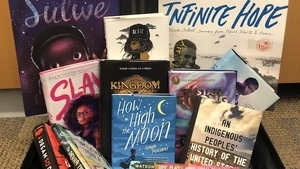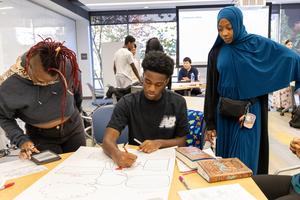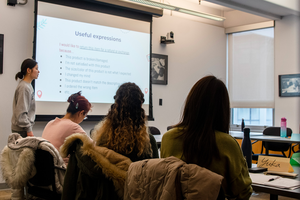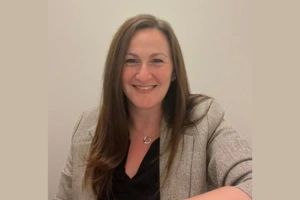This year saw an unprecedented level of public discussion and debate about race, identity, and representation in books for children and young adults. These necessary conversations are helping push the publishing industry to print more stories that reflect our diverse world.
But the books and authors that received the most attention in 2019 were often the ones at the center of controversy. Those flame wars left little room to highlight beautiful stories of perseverance, love, loss, and self-discovery.
In her 2019 list of the Best Books for Young Readers, Penn GSE’s Ebony Elizabeth Thomas hopes to showcase some of these overlooked stories. In choosing the list, Thomas and her team look for authors and illustrators whose work deals with issues like gender, race, ethnicity, religion, sexuality, and socioeconomic class in ways that are real and empathetic.
Thomas, author of The Dark Fantastic: Race and the Imagination from Harry Potter to the Hunger Games, also notes four trends that she expects will continue to shape children’s literature in 2020.
- Serious celebrity books: Celebrities have always written books for children. But these have often missed the mark. This year, Ibtihaj Muhammad, Lupita Nyong’o, Karyn Parsons, and George Takei wrote books that authentically connect with kids and teens.
- Imprints and influencers championing new creators: A decade of advocacy and action to change children’s publishing made its mark in 2019. An imprint helmed by a woman of color (Namrata Tripathi’s Kolkila Books) hit its stride in its second year. An imprint led by Native women (Cynthia Leitich Smith’s Heartdrum) is set to debut in 2020. And the work of a wide range of people and organizations—from Ebony LaDelle’s marketing team at HarperCollins, to Jennifer Baker’s Minorities in Publishing podcast, to researchers studying the industry, and mentors helping writers—will keep pushing children’s lit forward.
- Allies leveraging their voice: Rick Riordan rose to fame with his Percy Jackson series. He’s now using his “Rick Riordan Presents” imprint to promote authors of color like Kwame Mbalia. These Black male authors are writing for Black boys at the ages when they are most likely to stop reading. Other stars of children’s lit could make a huge difference by following Riordan’s lead.
- Memoir: Authors and illustrators continue to prove that the best true stories don’t have to be histories. Young readers, like all of us, want stories that they can see themselves in. Memoirs, in all forms, deliver.
Picture Books & Early Readers
The 2010s close with a veritable garden of picture books depicting all kinds of children and all kinds of families. This year’s picks include soaring visions that inspire (The Undefeated, The Proudest Blue, Sing a Song) as well as a bit of fun from school to home (The King of Kindergarten, My Papi Has a Motorcycle). Celebrations of family and food (Freedom Soup, Fry Bread, Bilal Cooks Daal, Magic Ramen, Amy Wu and the Perfect Bao) round our picks.
- Freedom Soup (Tami Charles & Jacqueline Alcántara; Candlewick)
- Leila in Saffron (Rukhsanna Guidroz & Dinara Mirtalipova; Salaam Reads; Simon & Schuster Books for You)
- Fry Bread: A Native American Family Story (Kevin Noble Maillard & Juana Martinez-Neal; Roaring Brook Press)
- The Proudest Blue: A Story of Hijab and Family (Ibtihaj Muhammad, S.K. Ali, & Hatem Aly; Little, Brown Books for Young Readers)
- The Undefeated (Kwame Alexander & Kadir Nelson; Versify)
- The King of Kindergarten (Derrick Barnes & Vanessa Brantley-Newton; Nancy Paulsen Books)
- Magic Ramen: The Story of Momofuku Ando (Andrea Wang & Kana Urbanowicz; little bee books)
- Bilal Cooks Daal (Aisha Saeed & Anoosha Syed; Salaam Reads/Simon & Schuster Books for You)
- Sing a Song: How “Lift Every Voice and Sing” Inspired Generations (Kelly Starling Lyons & Keith Mallett; Nancy Paulsen Books)
- My Papi Has a Motorcycle (Isabel Quintero & Zeke Peña; Kokila)
- Amy Wu and the Perfect Bao (Kat Zhang & Charlene Chua; Aladdin)
- Sulwe (Lupita Nyong’o & Vashti Harrison; Simon & Schuster Books for Young Readers)
Chapter Books & Middle Grade Readers
This was the year of #BlackBoyJoy in the middle grades! More than 55 years after we met Peter in Ezra Jack Keats’ The Snowy Day, we are pleased to see many different #ownvoices humanizing tales with Black boy protagonists (Look Both Ways, The Last Last-Day-of-Summer, The Usual Suspects). This is vital, as these stories are geared toward kids who often don’t see themselves in this category and, therefore, stop reading for pleasure. We are also pleased to note the work that Rick Riordan Presents is doing to diversify middle grades fantasy (Tristan Strong Punches a Hole in the Sky, Sal and Gabi Break the Universe), as well as adventures that are both magical and real (Lalani of the Distant Sea, The Bridge Home, Some Places More Than Others).
- The Library of Ever (Zeno Alexander; Imprint)
- The Usual Suspects (Maurice Broaddus; Katherine Tegen Books)
- The Last Last-Day-of-Summer (Lamar Giles & Dapo Adeola; Versify)
- Sal and Gabi Break the Universe (Carlos Hernandez; Rick Riordan Presents)
- Lalani of the Distant Sea (Erin Entrada Kelly; Greenwillow Books)
- Tristan Strong Punches a Hole in the Sky (Kwame Mbalia; Rick Riordan Presents)
- How High the Moon (Karyn Parsons; Little, Brown Books for Young Readers)
- Look Both Ways: A Tale Told in Ten Blocks (Jason Reynolds & Alexander Nabaum; Atheneum/Caitlyn Dlouhy Books)
- The Moon Within (Aida Salazar; Arthur A. Levine Books)
- Indian No More (Charlene Willing McManis & Traci Sorrell; Tu Books)
- Just South of Home (Karen Strong; Simon & Schuster Books for Young Readers)
- The Bridge Home (Padma Venkatraman; Nancy Paulsen Books)
- Some Places More Than Others (Renée Watson; Bloomsbury Children’s Books)
- The Dragon Thief (Zetta Elliott & Geneva B; Random House Books for Young Readers)
- Dough Boys (Paula Chase; Greenwillow)
Young Adult Readers
A continues to be a strong category. Five years after the #WeNeedDiverseBooks movement began, we are beginning to see genre diversity as well as experimentation. This year’s picks range from highly anticipated memoirs (Shout, Ordinary Hazards) to Black girls slaying all day as the stars of their own adventures (Slay, A Dream So Dark, War Girls), to hip hop realness (Let Me Hear a Rhyme, On the Come Up). Hard-hitting tales deftly bringing global stories to life (Internment, Patron Saints of Nothing) round out this year’s list.
- With the Fire on High (Elizabeth Acevedo; HarperTeen)
- Internment (Samira Ahmed; Little, Brown Books for Young Readers)
- Shout (Laurie Halse Anderson; Viking Books for Young Readers)
- Kingdom of Souls (Rena Barron; HarperTeen)
- The Everlasting Rose (Dhonielle Clayton; Freeform)
- Ordinary Hazards (Nikki Grimes; Wordsong)
- Let Me Hear a Rhyme (Tiffany D. Jackson; Katherine Tegen Books)
- Slay (Brittney Morris; Simon Pulse)
- A Dream So Dark (L.L. McKinney; Imprint)
- A Curse So Dark and Lonely (Brigid Kemmerer; Bloomsbury YA)
- War Girls (Tochi Onyebuchi; Razorbill)
- Patron Saints of Nothing (Randy Ribay; Kokila)
- On the Come Up (Angie Thomas; Balzer + Bray)
- An Indigenous Peoples’ History of the United States for Young People (Roxanne Dunbar-Ortiz, Jean Mendoza & Debbie Reese; Beacon Press)
Graphic Novels & Illustrated Texts
Graphic novels and illustrated texts continue to mature into diverse formats as creators, publishers, and audiences are increasingly open to the form. From picture books intended for older readers (Infinite Hope, The Women Who Caught the Babies), to graphic retellings of harrowing history (This Place: 150 Years Retold, They Called Us Enemy), to queer romance (B.B. Free, Laura Dean Keeps Breaking Up with Me), readers in high school and young adults will find much to appreciate here. Delights for our younger readers focused on new schools, new neighborhoods, and new ways of life (New Kid, My Life as an Ice Cream Sandwich).
- Infinite Hope: A Black Artist’s Journey from World War II to Peace (Ashley Bryan; Atheneum/Caitlyn Dlouhy Books)
- New Kid (Jerry Craft; HarperAlley)
- This Place: 150 Years Retold (Various authors & Illustrators; Highwater)
- The Women Who Caught the Babies (Eloise Greenfield & Daniel Minter; Alazar)
- B.B. Free (Gabby Rivera & Royal Dunlap; BOOM! Studios)
- Laura Dean Keeps Breaking Up with Me (Mariko Tamaki & Rosemary Valero-O'Connell; First Second)
- My Life as an Ice Cream Sandwich (Ibi Zoboi; Dutton Books for Young Readers)
- Palimpsest: Documents from a Korean Adoption (Lisa Wool-Rim Sjöblom; Drawn and Quarterly)
- They Called Us Enemy (George Takei, Justin Eisinger, Steven Scott & Harmony Becker; Top Shelf Productions)

Subscribe to the Educator's Playbook
Get the latest release of the Educator's Playbook delivered straight to your inbox.
Media Inquiries
Penn GSE Communications is here to help reporters connect with the education experts they need.









